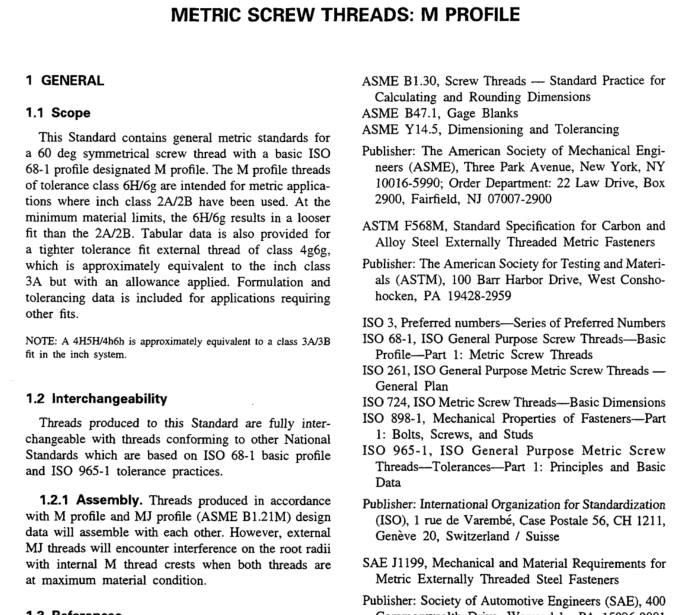ASME B1.13M pdf download

ASME B1.13M pdf download METRIC SCREW THREADS: M PROFILE
4 SERIES OF THREADS
4.1 Standard Coarse Pitch General Purpose and Mechanical Fastener Series, M Profile The standard metric screw thread series for general purpose equipment’s threaded components design and mechanical fasteners is a coarse thread series. Their diametedpitch combinations are listed in Table 4. NOTE: The words course and jne are given in order to conform to usage. No concept of quality shall be associated with these words. Coarse pitches only indicate the largest metric pitches used in current practice.
4.2 Standard Fine Pitch M ProfileScrew Threads Table 5 lists additional diametedpitch combinations that are standard for general purpose equipment’s threaded components design.
4.3 Preferred Sizes Diameterlpitch combinations shown in Table 4 are the preferred sizes and should be the first choice, as applicable.
4.4 IS0 Metric Thread Series The Thread Series given in Table 6 are identical to those published in IS0 261 for diameters of 1.6 mm and larger. Diametedpitch combinations from Tables 4 and 5 are shown in boldface. Selection of series shown in regular type shall be limited to unusual requirements where the selections in accordance with paras. 4.1, 4.2, and 4.3 cannot be used.
5 ALLOWANCES AND TOLERANCES
5.1 IS0 System of Limits and Fits as Applied to Screw Threads
5.1.1 General. The international metric tolerance system is based on a system of limits and fits. The limits of the tolerances on the mating parts and their allowances (fundamental deviations) determine the fit of the assembly. For simplicity the system is described for cylindrical parts. Holes are equivalent to internally threaded surfaces and shafts to externally threaded surfaces.
5.1.2 Basic Size. This is the zero line or surface at assembly, where the interface of the two mating parts have a common reference.
5.1.3 Upper Deviation. This is the algebraic dif- ference between the maximum limit of size and the basic size. It is designated by the French term écart superieur (ES for holes and es for shafts).
5.1.4 Lower Deviation. This is the algebraic dif- ference between the minimum limit of size and the basic size. It is designated by the French term écart inferieur (EI for holes and ei for shafts).
5.1.5 Fundamental Deviations (Allowances). These are the deviations that are closest to the basic size. In Fig. 4 they would be EI and es. Fundamental deviations are designated by alphabetical letters. See para. 5.3.
5.1.6 Fits. Fits are determined by the fundamental deviation, which may be positive or negative, assigned to the mating parts. The selected fits can be clearance, transition, and interference. To illustrate fits schematically, a zero line is drawn to represent the basic size. By convention, the shaft always lies below the zero line and the hole lies above the zero line (except for interference fits). This makes the fundamental deviation negative for the shaft and equal to its upper deviation (es). The fundamental deviation is positive for the hole and equal to its lower deviation (EI>. See Fig. 4. 5.1.7 Tolerance. Defined by a series of numerical grades, each grade provides numerical values for nomi- nal sizes corresponding to the standard tolerance. See para. 5.2. When the tolerance is applied to the schematic diagram, the tolerance for the part (shaft) continues to be negative. Thus, the tolerance plus the fit define the lower deviation (ei).
The tolerance for the mating part (hole) continues to be positive. Thus, the tolerance plus the fit define the upper deviation (ES). A schematic example of the metric tolerance system as applied to metric screw threads is shown in Fig. 4.
5.2 Tolerance Grade (a) This is indicated by a number. The system provides for a series of tolerance grades for each of the four screw thread parameters (DI, d, Dz. dz). The tolerance grades for this Standard were selected from those given in IS0 965-1. (b) The underlined tolerance grades are used with normal length of thread engagement.









